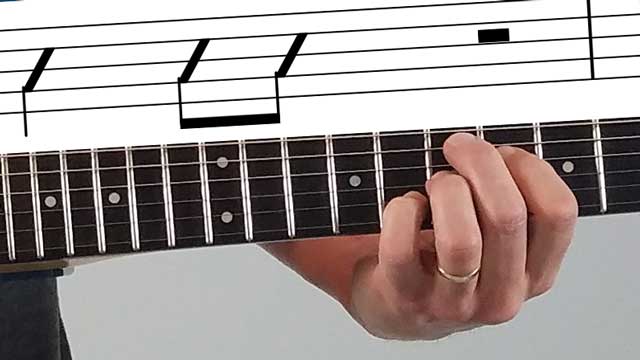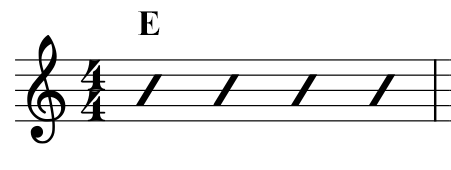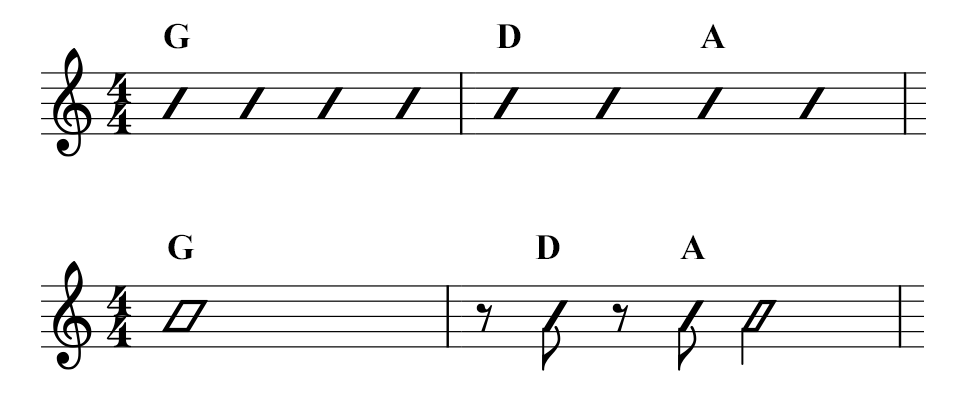
Even if you don’t know how to read standard music notation, you should know how to read slash notation on the guitar. This is a form of musical notation that uses some of the symbols of standard notation but in a more simplified way. The goal is to show the chords that need to be played, without indicating the rhythm. (Although, as you’ll see below, sometimes basic rhythms are shown.)
The term “slash notation” comes from the use of slashes, which are a simple shorthand for saying “play the chord”. The easiest way to explain this is with an example. In the diagram below, the chord symbol (“E”) at the top and the four slashes on the staff mean “play the E chord for four beats”.

The slashes appear on a standard musical staff, and include a time signature (4/4) and, sometimes, a treble clef. Since we’re not playing individual notes, the clef is not really necessary here but is often included anyway. The time signature, on the other hand, is important because it indicates how many beats there are in a measure. If you don’t know how to read music, the top number indicates the number of beats per measure. (Most of the time, this just tells you whether you should count “1-2-3-4, 1-2-3-4,…” or “1-2-3, 1-2-3,…”). But for more details on that, take a look at Wikipedia’s article on time signatures.
Slash Notation with Rhythms
There are a couple of different types of slash notation. One version indicates the rhythm to play and the other doesn’t. When slash symbols appear regularly in a bar, like above, this typically means that the rhythm is not being indicated. In other words, the diagram is just saying “play E for four beats” but it’s not saying “play the E chord exactly four times, once per beat.
But other times, the slashes that are used actually represent rhythmic values. Check out this image, which shows two different types of slash notation for the same song:

The top staff shows basic slash notation, which doesn’t show the rhythms to be played. Instead, it shows which chords to play for which beats. So, in the first measure, you play G for four beats. Then, in the second measure, you play D for two beats, and then A for two beats.
In contrast, the bottom staff shows not only the chords, but also the actual rhythms that should be played. First you play the G chord once and let it ring out for all four beats. Then, in the second measure, the D is played on the upbeat of the “1” count, and the A is played on the upbeat of the “2” count and again on the downbeat of the “3” count. As you can see, the slashes are more than just slashes—they’re kind of a “slash version” of musical notes, that correspond to the time value of those notes. So that first slash that represents a whole note is round, like a whole note in standard musical notation:

To read these kinds of rhythms, you’ll have to know basic concepts of standard notation like note values, ties, dotted rhythms, etc. You can find this info in the lesson on musical symbols and in various articles and videos on the Web.
Neither of the above notations is more “correct” than the other; they’re just used for different purposes.
Lyrics With Chord Symbols
If you already know a song, you probably don’t need to have the rhythm notated. You might just want to know what chords are played and when. On the other hand, if you’re trying to play a song you’ve never heard, you probably need to know the rhythm. This is especially true if the song has some kind of distinctive rhythm.
In fact, if you know a song well, you probably don’t even need the staff or slash symbols—you might just need to see the chord symbols. You’ve probably seen this on the internet, where the lyrics of a song are displayed with the chord symbols above them. This assumes that you already know (or can figure out by listening) when the chord changes happen. In this case, you just want to know which chords to play.
For example, this song starts with a D chord, and then changes to G on “all”. It then changes back to D on the word “day”. It stays on D until switching to an E chord on the word “pass”. And so on.
D G D
I’ve been workin’ on the railroad, all the live long day
D E A
I’ve been workin’ on the railroad, just to pass the time away…
This is obviously much more compact than writing out the actual slashes on a musical staff. It’s also a convenient way to see the lyrics at the same time without taking up too much space. But it wouldn’t be as useful for a song you weren’t already familiar with or that had more complex rhythms.
That’s slash notation for you, and that wraps up this four-part series of lessons on guitar notation. If you haven’t read the other lessons, I’d suggest checking them out. You can start with the first lesson on chord boxes.
